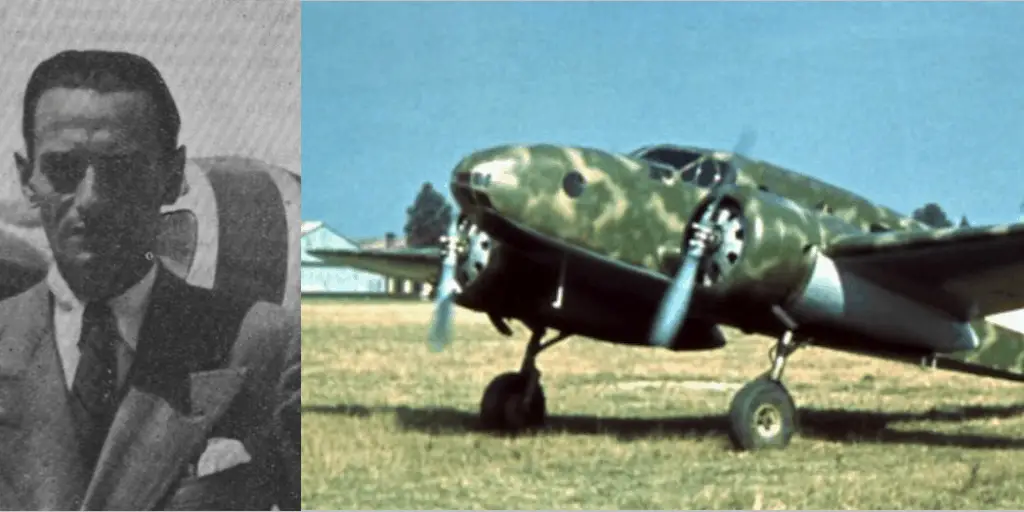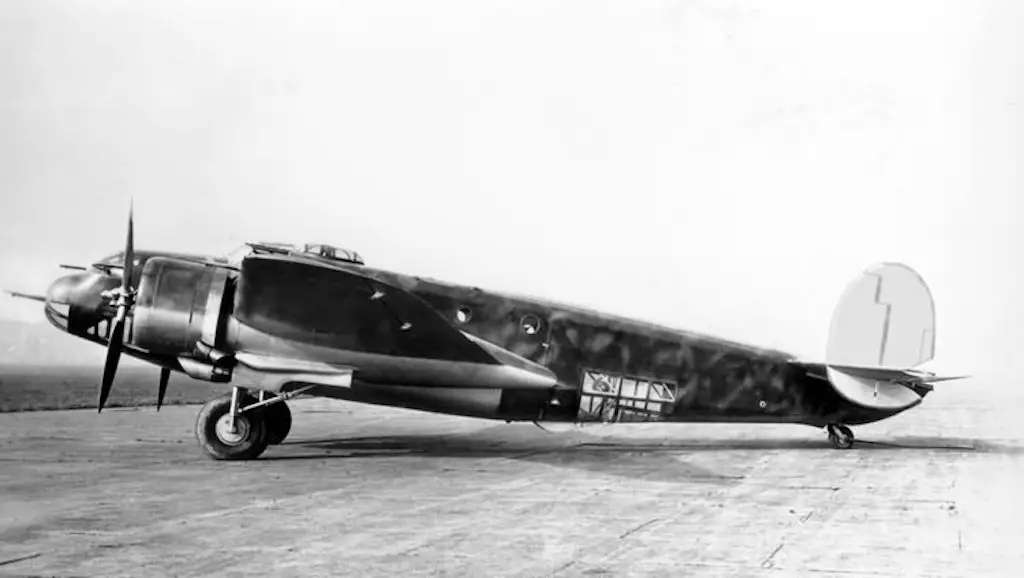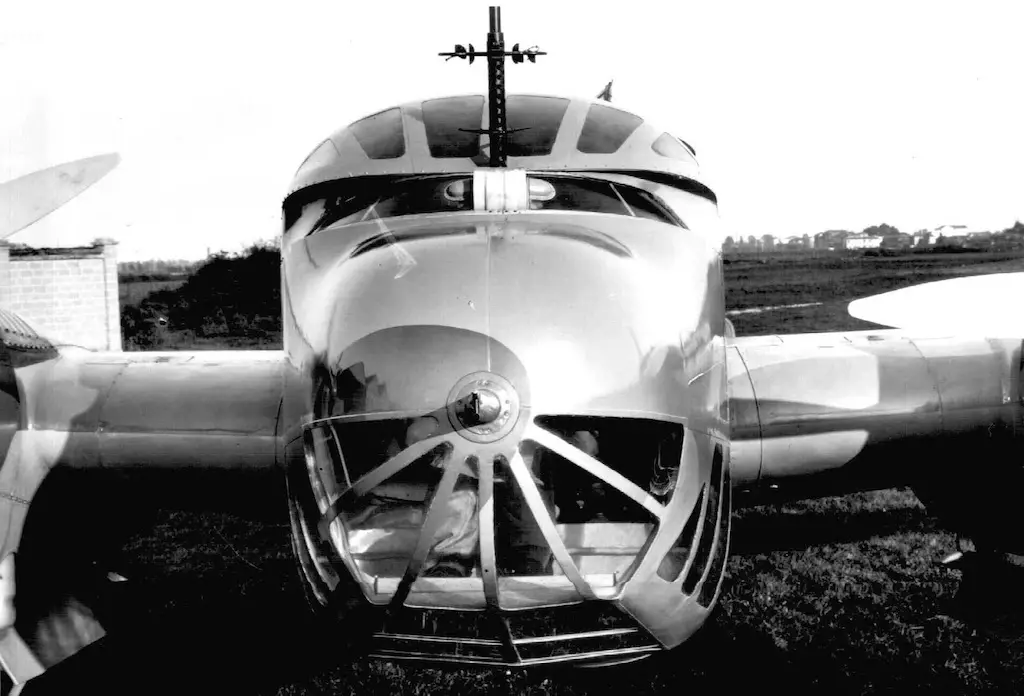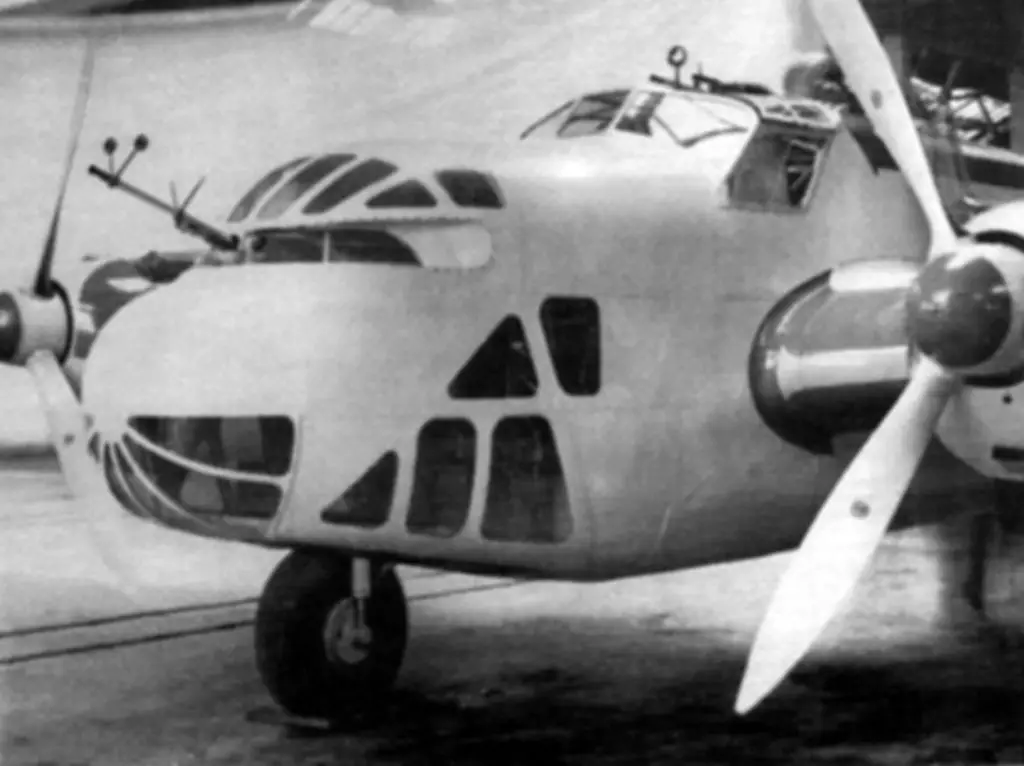Despite its design, development and ultimately its production at Caproni’s subsidiary, the Ca.135 was originally meanto to be built at the company’s main facility in Taliedo. This is why it uses the “Caproni” nomenclature as opposed to the Caproni Bergamasca Ca. 300 series.

Cesare Pallavicino (L) designed the Caproni Ca.310 and Ca.135.
The catalyst for Caproni’s initial commitment to the design was the arrival of Cesare Pallavicino as the chief designer from Breda in 1935. Additionally, the Regia Aeronautica formally requested a requirement for an advanced twin-engine medium bomber.
Design
This requirement called for a maximum speed of 240 mph at optimum altitude. The ability to carry a bomb load of 2,646 pounds over a range of 621 miles and the ability to maintain an altitude of 16,450 ft with one engine.

Side view of the Caproni Ca.135.
Pallavicino laid out a trim cantilever monoplane of mixed construction with the two engines located in wing-mounted nacelles and the crew grouped in the forward and central fuselage. The fuselage was based on a forward section of light alloy semi-monocoque construction to which was added a rear fuselage section of welded steel tubes with fabric covering.
Caproni Ca.310 Details and Specifications
To this were added the tailwheel landing gear. This included a semi-retractable tailwheel and main units that retracted into the underside of the two engine nacelles. The tail unit comprised a twin vertical surface located about mid-span of its two halves, and the wing comprised two dihedral halves that were tapered in thickness and chord.
The wings were of mixed metal and wood construction and had plywood skinning and fabric covering on their forward and rear sections respectively.
Armament
Defensive armament was provided in the form of three Breda turrets. Each could carry a single 12.7mm machine gun or two 7.7mm machine guns, and the dorsal and ventral turrets were of a semi-retractable type to reduce drag in cruising flight. The CA.135 bomb load capacity was 1,474 kg (3,250 lb).
Prototype
The prototype made its first flight in 01 April 1935. The aircraft was powered by two 800 hp Isotta-Fraschini Asso XI RC Vee engines driving a wooden two-bladed propeller. The propeller was soon exchanged for a three-bladed metal propeller and subsequently accepted for all production versions.
Tipo Spagna
The Regia Aeronautica felt the Ca.135 had potential and in 1936 ordered 14 examples of the Ca.135 Tipo Spagna (Spanish model), presumably as it was intended to undertake an operational evaluation in the Spanish Civil War. However, none of the aircraft served with the Aviazione Legionaria in Spain.

A forward view of the Caproni Ca.135.
The Ca.135 Tipo Spagna was then re-designated as the Ca.135/Asso for its two 836 hp Asso XI RC.40 Vee engines. But even with this slightly uprated powerplant, the performance of this pre-production model was degraded in comparison with the prototype. In addition to the operational equipment and extra fuel capacity, the weight was increased resulting in a lower maximum speed to 249 mph and a cruising speed reduced to 227 mph at optimum altitude. The climb rate and service ceiling were also reduced while the range was increased.
Tipo Peru
The Ca.135 Tipo Peru (Peru model) was initially ordered in 1936 for 6 bombers but eventually, 32 bombers were delivered. The aircraft differed from the initial Italian mode. Gun positions were revised with streamlined nacelles for the two 900 hp Asso XI RC.40 engines. These aircraft were used operationally by Peru in the Grand Chaco War of 1941 against Ecuador and proved moderately successful by South American standards.

The “Tipo Perú” at the Taliedo plant. Photo: Andrea Devetti.
The Italian Air Force felt that the Ca.135 was limited by its comparative lack of power. Caproni proposed a version with two 910 hp Hispano Suiza 12Y-31 engines. But the Regia Aeronautica refused to consider a version with French engines as France and Italy were at loggerheads.
Therefore, in early in 1938, the Ca.135 Tipo Spagna airframes were revised for trials with a pair of uprated 1,000 HP engines. These two engines were the Fiat A.80 RC.41s or Piaggio P.XI.RC.40 radials. Trials revealed that the Fiat engines were unreliable and failed to improve performance as significantly as the Piaggio engines. The few Fiat powered bombers were withdrawn from front-line service and transferred to bomber schools.
P.XI
The Piaggio engine aircraft proved altogether more successful, especially after they had been revised with a new nose section that was somewhat cleaner than the Ca.135 Tipo Spagna. The opportunity was also taken to replace the original Breda dorsal turret with a more modern Caproni-Lanciani turret. Despite its improved performance, the Ca.135/P.XI was not ordered by the Regia Aeronautica. By this point, the preference was geared for tri-motor bombers such as the CANT Z.1007 and SM.79. The Imperial Japanese army air force also evaluated the type in competition to the Fiat BR.20 and preferred the latter.
Hungarian Air Force
Production of the Ca.135/P.XI centered on exports. The Hungarian Air Force received 100 of the type in 1939 and 1940. The aircraft operated with limited success against the Soviets in 1941 and 1942 after Hungarycommitted its forces to operations on the Eastern Front.
The last development of the series was the Ca.135bis/Alfa powered by two 1,400 hp Alfa Romeo 135 RC.32 Tornado radial engines. This prototype had a maximum speed of 301 mph. It was clear by this time that the development potential of the Ca.135 was marginal and no further production was authorized.
Caproni Ca.135 P.XI Specifications
| Model | Ansaldo A.120Ady |
|---|---|
| Crew | 2 Pilot and Observer |
| Powerplant | (1) Fiat A.22 550 HP |
| Maximum Speed | 158 mph (254 Km/h) |
| Max Ceiling | 23,000 ft (7,000 m) |
| Range | |
| Length | 28 ft 3 in (8.6 m) |
| Height | 9 ft 2 in (2.8 m) |
| Wingspan | 42 ft 0 in (12.8 m) |
| Weight | Empty: Max: |
| Armament | (1) or (2) forward-firing 7.7. mm machine guns (1) Rearward-firing 7.7 mm machine gun for observer |